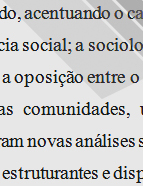

................................
Newton de Macedo (UP), concerned with listening to the reformist currents and the reception of the ideals of modernity that guided the transformations of culture in Portugal, pays particular attention to Pombal’s reform of cultural and educational institutions, from “minor studies” to the University. The creation, regulation and role of the ARCL, as well as the Royal Public Library of Lisbon, also deserve analysis by the historian. The development of artistic education, with the creation of drawing classes in Lisbon and Porto, as well as military studies, with the creation of the Royal Naval Academy and the Military College, also deserve to be addressed in order to understand their respective regulations and the social role they played. The development of public education and culture brought about by the Setembrismo movement is analysed in detail, with particular emphasis on the creation and/or development of technical and medical-surgical education. The Higher Course in Letters and the industrial and commercial institutes also deserve analysis in terms of their creation, regulation and functioning, while the educational reforms carried out by the Republic are characterised in general terms. The concern to understand the cultural and ideological movements underlying the institutional transformations is always present.
Finally, António Baião, Director of the Torre do Tombo, was responsible for dealing with the Inquisition and the Society of Jesus, which he addressed from its introduction and development in Portugal to the role it played in the spread of Christianity in the East and Brazil, without forgetting the important relationship between the Society and the royal power. As for the Inquisition, the author presents the entire history of the creation of the tribunal, its regulation and functioning, without forgetting the internal struggles and disputes between the Portuguese Court and the Roman Curia regarding this new institution. The court’s actions are described from the “benevolent” phase to the “violent” phase, with reference to the legal and ecclesiastical instruments (papal bulls and briefs) that shaped the inquisitorial function. The analysis extends to the functioning of the court and its relationship with political power, i.e. a comprehensive approach to the institution and the role it played in the political and social context of the time.
This work is financed by national funds through FCT - Foundation for Science and Technology, I.P, in the scope of the projects UIDB/04311/2020 and UIDP/04311/2020.
